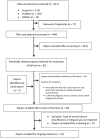Risk factors associated with sacral stress fractures: a systematic review
- PMID: 26109829
- PMCID: PMC4461718
- DOI: 10.1179/2042618613Y.0000000055
Risk factors associated with sacral stress fractures: a systematic review
Abstract
Objectives: The objective of this study was to examine and identify risk factors associated with the development of sacral stress fractures in order to improve diagnosis in clinical practice.
Methods: Electronic search strategies in PubMed, CINAHL, Scopus, and SPORTDiscus were combined with a hand search to identify articles for inclusion. Studies were considered if they described patient cases in which imaging confirmed diagnosis of a sacral stress fracture, and the diagnosis included whether the fracture was a sacral insufficiency or sacral fatigue stress fracture.
Results: In those that developed sacral insufficiency fractures, the risk factors that were most prevalent included osteoporosis, pelvic radiation therapy, rheumatoid arthritis, long-term corticosteroid therapy, and postmenopausal, each with a prevalence of 100%. Risk factors with 100% prevalence in those diagnosed with sacral fatigue fractures included recent increase in training intensity and deficient diet.
Discussion: A pattern of signs and symptoms are consistent among subjects with sacral stress fractures. Patients being unsuccessfully treated for low-back and buttock pain who fit the risk factor profiles for sacral stress fractures should be referred to a physician for further diagnostic workup.
Keywords: Fatigue fracture; Insufficiency fracture; Risk factors; Sacral stress fracture.
Figures
References
-
- Lin JT, Lane JM. Sacral stress fractures. J Womens Health. 2003;12:879–87. - PubMed
-
- Zaman FM, Frey M, Slipman CW. Sacral stress fractures. Curr Sports Med Rep. 2006;5:37–43. - PubMed
-
- Micheli LJ, Curtis C. Stress fractures in the spine and sacrum. Clin Sports Med. 2006;25:75–88. - PubMed
-
- Hoy D, Bain C, Williams G, March L, Brooks P, Blyth F, et al. A systematic review of the global prevalence of low back pain. Arthritis Rheum. 2012;64:2028–37. - PubMed
Publication types
LinkOut - more resources
Full Text Sources
Other Literature Sources

